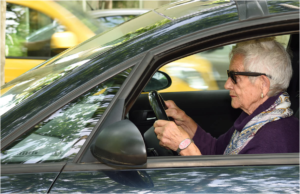Even if we need to give things up, we can still decide when and how
By Debbie Reslock for Next Avenue
Sometimes, growing older feels like one loss after another. No longer being able to drive or stay in our own home is difficult to accept. If we feel we are forced into those decisions, it can be harder still.
Yet when we put off making the decisions ourselves, others are pressed to step in. On the other hand, when we understand what we’re afraid of, we’re able to discover options that can alleviate the fear and take responsibility for the decisions that are truly ours to make. Here are three aging decisions to make before someone makes them for you:
1. The Decision to Stop Driving
According to the AAA Foundation for Traffic Safety, drivers in their 50s and 60s have one of the lowest crash rates of any age. This starts to rise after the late 60s and early 70s and increases more rapidly after 75. But there’s not a universal age when driving is no longer safe.
What we fear most is the loss of independence. Having a car means freedom. Asking for rides feels like we’re a burden. It affects our health as well.
“You can age at home, but if you can’t drive or have access to transportation services, it can be very isolating,” says Natalie Galucia, executive director of the St. Louis-based Village to Village Network. The network collaborates to support the Village Movement, a membership organization that provides key services for aging-in-place.
To make the driving decision yourself, first complete a short self-assessment for an honest look at your driving skills. Then, make adjustments to your driving if needed. There’s a wide range of choices before hanging up the keys, including taking a refresher driving course or avoiding high-speed highways. Finally, determine how you’ll decide if it is time to stop driving. Plan for that day and what possibilities will help you keep your freedom.
You should also consider alternatives to driving. These include: the local bus or rail system, which often provides discount fares for those 65+; transportation offered through senior centers, churches or other organizations; membership to The Villages or similar programs providing transportation and ride services including Uber, Lyft or taxis. Depending on your area, accessible vehicles are often available.
2. The Decision to Stay in Your Home
The first choice here may be deciding where your home will be. The presence of adult children in multiple states or recreational preferences all weigh on the decision. Many things can play a role in whether to stay put, according to Lyndall Hare, a Charlotte, N.C., gerontologist.
And it’s not just the dwelling we may need to worry about. “If you’re living in areas of the country that are booming, you may be getting pushed out,” Hare says. “As gentrification sets in, property taxes increase and some might find they can no longer afford their neighborhood.”
We can struggle with the choices, but we’re trying to hang on to our self-sufficiency. And we often ignore reality when we say we want to age in homes that can’t support that. “What worked for you in your 30s, 40s and 50s may not work the same when you’re in your 60s, 70s and 80s,” says Galucia.
Review the checklist from the National Association of Home Builders (NAHB) for what makes an age-friendly home. Then, talk to a remodeler about which modifications your house might need. (The NAHB has a list of Certified Aging-in-Place Specialists.)
Think, too, about what situations might make you uncomfortable living alone and actions you can take to avoid them.
“We need a sense of belonging wherever we live, so if you do move, consider how you’ll integrate yourself into the new community,” Hare says. And if you don’t move, those you count on for support might, so be ready for change, she adds.
Moving to a home in an active adult community offers a maintenance-free lifestyle, built-in activities and opportunities to make friends.
3. The Decision to Take Care of Yourself
Struggling with daily life not only presents challenges as we age but can contribute to depression and isolation.
No longer being self-reliant is hard to accept, but it can be the reality. If help is needed, some people find professional assistance more comfortable than care from a family member. But cost is often a factor.
To make this decision, research in-home and home-health care services and their costs, familiarize yourself with your local Area Agency on Aging’s services and review your finances to determine additional resources you might need for home care.
Then, consider alternative options such as:
- Adult day centers that offer meals, transportation or activities
- Home health care services provided by licensed professionals, including physical or occupational therapists and nurses
- Home care agencies that help with the activities of daily living
- Local programs that combine all three
The Need to Be Proactive
We’re not the first generation to navigate aging, and some aspects never change. “Frailty will look the same, even for baby boomers,” says Price. “But the interactions and how we approach it can be different.”
We didn’t make it this far without knowing that life can go its own way, regardless of our plans. But if we want to make our own decisions about how we live, we need to be proactive.
“Ask yourself what your life will look like 20, 30 or 40 years down the road, what might need to change, and then start making some of those changes now,” Galucia recommends. “Because if you wait till later, it can be a crisis or need an emergency-type fix,” she says.
And that’s a sure way the decisions can be taken out of our hands.
© Twin Cities Public Television – 2017. All rights reserved.







Very interesting information. Thanks.